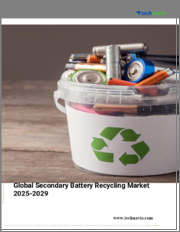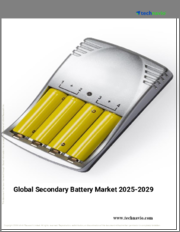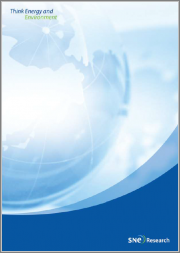
|
시장보고서
상품코드
1569745
세계의 티탄산리튬 배터리 시장 예측(-2030년) : 유형별, 형상별, 용량별, 용도별, 지역별 분석Lithium Titanate Battery Market Forecasts to 2030 - Global Analysis By Type (Power Lithium Titanate Batteries and Energy Lithium Titanate Batteries), Form, Capacity, Application and By Geography |
||||||
Stratistics MRC에 따르면, 티탄산 리튬 배터리 세계 시장은 2024년에 47억 2,000만 달러를 차지하고, 예측 기간 중 CAGR 12.4%로 성장하여 2030년에는 93억 7,000만 달러에 이를 전망입니다.
티탄산 리튬 배터리(LTO)는 기존의 흑연 대신에 티탄산 리튬(Li4Ti5O12)을 음극 재료로 사용하는 이차 배터리의 일종입니다. 이 구성에 의해 충방전 속도의 고속화, 안전성의 향상, 수명의 연장이 가능해져, 통상 10,000회 이상의 충전 사이클이 가능합니다. LTO 배터리는 더 넓은 온도 범위에서 작동하며 우수한 열 안정성을 나타내므로 전기자동차 및 재생 가능 에너지 저장과 같은 고출력 용도에 적합합니다.
IEA의 연간 섹터 평가에 따르면 세계의 재생 가능 에너지 발전 용량은 2022년에서 2027년 사이에 2,400기가톤(GW) 증가합니다.
전기차 보급 확대
LTO 배터리는 높은 충방전 속도, 긴 사이클 수명, 높은 안전성을 평가하며 급속 충전 및 긴 수명이 필요한 전기자동차에 이상적입니다. EV 시장이 확대됨에 따라 제조업체는 성능과 내구성 기준을 충족하는 LTO 배터리를 찾고 있으며, 이 분야에 대한 투자와 개척이 진행되고 있습니다. 그 결과, EV의 인기가 높아짐에 따라 LTO 배터리 시장의 성장을 가속하고, 생산과 기술 혁신 모두를 뒷받침하고 있습니다.
낮은 에너지 밀도
티탄산 리튬 배터리는 음극 재료에 티탄산 리튬을 사용하고 있기 때문에 다른 리튬 이온 배터리에 비해 에너지 밀도가 낮고, 에너지 저장 용량이 작아집니다. 이로 인해 휴대용 전자기기나 전기자동차 등 에너지 밀도가 높은 환경에서의 용도가 제한되어 시장 성장을 방해하고 있습니다. 그 결과, 에너지 저장 능력의 저하는 보다 긴 수명으로 대용량의 배터리 솔루션을 요구하는 잠재적인 사용자의 부족이 될 수 있습니다.
신재생에너지 프로젝트 증가
급속 충전 기능, 긴 수명 및 안전성으로 알려진 LTO 배터리는 햇빛과 풍력과 같은 간헐적 인 에너지 원을 관리하는 데 이상적입니다. 신재생에너지 시스템의 안정성과 효율을 높이는 에너지 저장 솔루션에 대한 수요가 증가하고 있습니다. 현저한 열화 없이 빈번한 충방전 사이클을 처리할 수 있기 때문에 재생 가능 에너지를 그리드에 통합하고, 전기자동차를 지원하는데 가치가 있어 시장의 확대와 보급을 가속화하고 있습니다.
기술 경쟁
티탄산 리튬 배터리 시장에서의 기술 경쟁은 배터리의 성능, 비용, 효율 향상을 목표로 한 급속한 진보와 기술 혁신에 의해 발생하고 있습니다. 이 경쟁은 각 회사가 뛰어난 기술을 확립하려고 싸우기 때문에 불확실성과 단편화를 낳고 있습니다. 게다가 높은 연구개발비와 지속적인 기술 혁신의 필요성에 의해 재원이 박박할 가능성도 있습니다. 또한 경쟁 기술은 보다 매력적인 대체 기술을 제공하고 LTO 시장의 잠재력에 영향을 미칠 수 있습니다.
COVID-19의 영향
COVID-19의 대유행은 제조 지연과 공급망의 중단을 일으켜 생산량 감소와 비용 상승을 초래하여 리튬 티탄산 배터리 시장을 혼란시켰습니다. 그러나 팬데믹은 에너지 저장과 청정 에너지 솔루션에 대한 주목을 가속화하여 긴 수명과 안전성을 특징으로 하는 LTO 배터리에 대한 관심을 높였습니다. 산업이 회복되고 전기자동차와 재생 가능 에너지에 대한 수요가 증가함에 따라 LTO 시장은 회복 될 것으로 예상됩니다.
예측 기간 동안 원통형 셀 부문이 최대가 될 전망
예측 기간 동안 원통형 셀 부문이 최대 시장 점유율을 보장할 것으로 예상됩니다. 원통형 셀의 티탄산 리튬 배터리는 고출력 용도에 이상적인 컴팩트하고 견고한 설계를 제공합니다. 이 셀은 고속 충 방전 기능, 탁월한 안전성, 긴 사이클 수명을 제공하며 전기자동차 및 산업용 에너지 저장에 적합합니다. 원통형은 기계적 안정성과 열 관리를 강화하여 전반적인 신뢰성과 성능에 기여합니다.
에너지 저장 시스템 분야는 예측 기간 동안 가장 높은 CAGR이 예상된다.
에너지 저장 시스템 분야는 급속 충전, 긴 사이클 수명, 높은 안전성으로 인해 전력망의 안정화와 재생 가능 에너지의 통합에 이상적이기 때문에 예측 기간 동안 가장 높은 CAGR이 예상됩니다. 급속 충방전이 가능하므로 피크 부하나 에너지 변동에 효율적으로 대응할 수 있어 송전망의 신뢰성을 높일 수 있습니다. LTO 배터리는 간헐적 인 에너지 원을 관리하고 신뢰할 수있는 백업 전원을 제공하기 위해 내구성과 성능을 평가합니다.
최대 점유율을 가진 지역
아시아태평양은 급속한 산업화와 전기자동차 및 재생 가능 에너지 저장 솔루션 수요 증가로 예측 기간 동안 최대 시장 점유율을 차지할 것으로 예상됩니다. 중국, 일본, 한국과 같은 국가들은 견조한 자동차 부문과 기술 부문을 통해 진보를 이끌고 있습니다. 이 지역은 에너지 저장 인프라에 대한 많은 투자와 청정 에너지를 추진하는 정부의 지원 정책으로부터 이익을 얻고 있습니다. 고성능, 내구성이 뛰어난 배터리에 중점을 둔 LTO 기술은 이 역동적인 시장의 진화하는 요구를 충족시키는 데 유리한 위치에 있습니다.
CAGR이 가장 높은 지역:
북미는 전기차와 신재생에너지 저장에 대한 투자 증가로 예측 기간 동안 가장 높은 CAGR을 나타낼 것으로 예측됩니다. 미국과 캐나다는 정부의 장려책과 이산화탄소 배출량 감축에 초점을 맞추고 있으며, 첨단 배터리 기술의 채택으로 최첨단을 달리고 있습니다. 자동차 및 에너지 등 주요 산업은 사이클 수명이 길고 안전성이 우수한 LTO 배터리를 적극적으로 채용하고 있습니다. 지속가능한 에너지 솔루션과 기술 혁신이 중시되고 있으며, 이 지역의 LTO 시장 성장에 바람직한 환경이 조성되고 있습니다.
무료 주문을 받아서 만드는 서비스:
이 보고서를 구독하는 고객은 다음과 같은 무료 맞춤설정 옵션 중 하나를 제공합니다.
- 기업 프로파일
- 추가 시장 기업의 종합적 프로파일링(3개사까지)
- 주요 기업의 SWOT 분석(3개사까지)
- 지역 세분화
- 고객의 관심에 응한 주요국 시장 추계·예측·CAGR(주: 타당성 확인에 따름)
- 경쟁 벤치마킹
- 제품 포트폴리오, 지리적 존재, 전략적 제휴에 기반한 주요 기업 벤치마킹
목차
제1장 주요 요약
제2장 서문
- 개요
- 이해관계자
- 조사 범위
- 조사 방법
- 데이터 마이닝
- 데이터 분석
- 데이터 검증
- 조사 접근
- 조사 정보원
- 1차 조사 정보원
- 2차 조사 정보원
- 전제조건
제3장 시장 동향 분석
- 성장 촉진요인
- 억제요인
- 기회
- 위협
- 용도 분석
- 신흥 시장
- COVID-19의 영향
제4장 Porter's Five Forces 분석
- 공급기업의 협상력
- 구매자의 협상력
- 대체품의 위협
- 신규 진입업자의 위협
- 경쟁 기업간 경쟁 관계
제5장 세계의 티탄산리튬 배터리 시장 : 유형별
- 파워 티탄산 리튬 배터리
- 에너지 티탄산 리튬 배터리
제6장 세계의 티탄산 리튬 배터리 시장 : 형상별
- 프리즈매틱 셀
- 원통형 셀
- 파우치 셀
- 커스텀 모양
- 모듈 팩
- 기타 형상
제7장 세계의 티탄산리튬 배터리 시장 : 용량별
- 저용량(20Ah 미만)
- 중용량(20-100Ah)
- 고용량(100Ah 이상)
제8장 세계의 티탄산리튬 배터리 시장 : 용도별
- 자동차
- 가전
- 산업
- 항공우주 및 방어
- 의료기기
- 에너지 저장 시스템
- 기타 용도
제9장 세계의 티탄산리튬 배터리 시장 :지역별
- 북미
- 미국
- 캐나다
- 멕시코
- 유럽
- 독일
- 영국
- 이탈리아
- 프랑스
- 스페인
- 기타 유럽
- 아시아태평양
- 일본
- 중국
- 인도
- 호주
- 뉴질랜드
- 한국
- 기타 아시아태평양
- 남미
- 아르헨티나
- 브라질
- 칠레
- 기타 남미
- 중동 및 아프리카
- 사우디아라비아
- 아랍에미리트(UAE)
- 카타르
- 남아프리카
- 기타 중동 및 아프리카
제10장 주요 발전
- 계약/파트너십/협업/합작투자(JV)
- 인수와 합병
- 신제품 발매
- 사업 확대
- 기타 주요 전략
제11장 기업 프로파일링
- Toshiba Corporation
- Johnson Controls International
- Hitachi Chemical Corporation
- Samsung SDI
- E-One Moli Energy Corporation
- Valence Technology
- Leydenjar Technologies
- Altairnano
- Nano One Materials
- Shenzhen Kstar Science and Technology Company Limited
- A123 Systems
- ProLogium Technology
- BYD Company
- K2 Energy Solutions
According to Stratistics MRC, the Global Lithium Titanate Battery Market is accounted for $4.72 billion in 2024 and is expected to reach $9.37 billion by 2030 growing at a CAGR of 12.4% during the forecast period. A Lithium Titanate Battery (LTO) is a type of rechargeable battery that uses lithium titanate (Li4Ti5O12) as the anode material instead of conventional graphite. This composition allows for faster charge and discharge rates, enhanced safety, and a longer lifespan, typically offering over 10,000 charge cycles. LTO batteries operate at a wider temperature range and exhibit excellent thermal stability, making them suitable for high-power applications such as electric vehicles and renewable energy storage.
According to the IEA's annual sector assessment, global renewable power capacity would increase by 2,400 gigatonnes (GW) between 2022 and 2027.
Market Dynamics:
Driver:
Increased adoption of electric vehicles
LTO batteries are valued for their high charge/discharge rates, long cycle life, and enhanced safety, making them ideal for EVs that require rapid charging and extended longevity. As the EV market expands, manufacturers seek LTO batteries to meet performance and durability standards, leading to greater investment and development in this sector. Consequently, the rising popularity of EVs fuels the growth of the LTO battery market, boosting both production and innovation.
Restraint:
Lower energy density
Lithium Titanate batteries have lower energy density compared to other lithium-ion batteries due to their use of lithium titanate as the anode material, which results in a lower capacity for energy storage. This hampers market growth by limiting their application in energy-dense environments like portable electronics and electric vehicles, where higher energy density is crucial. Consequently, the reduced energy storage capability can deter potential users seeking longer-lasting or higher-capacity battery solutions.
Opportunity:
Rise in renewable energy projects
LTO batteries, known for their rapid charging capabilities, long life cycles, and safety, are ideal for managing intermittent energy sources like solar and wind. They increase the demand for energy storage solutions that enhance the stability and efficiency of renewable energy systems. Their ability to handle frequent charge-discharge cycles without significant degradation makes them valuable for integrating renewable energy into the grid and supporting electric vehicles, thereby accelerating market expansion and adoption.
Threat:
Technological competition
Technological competition in the lithium titanate battery market arises from rapid advancements and innovations aimed at improving battery performance, cost, and efficiency. This competition creates uncertainty and fragmentation, as companies vie to establish superior technologies. Additionally, high R&D costs and the need for continuous innovation can strain financial resources. Moreover, competing technologies may offer more appealing alternatives, affecting LTO market potential.
Covid-19 Impact
The covid-19 pandemic disrupted the lithium titanate battery market by causing delays in manufacturing and supply chain interruptions, leading to reduced production and higher costs. However, the pandemic also accelerated the focus on energy storage and clean energy solutions, boosting interest in LTO batteries for their long lifespan and safety features. As industries recover and demand for electric vehicles and renewable energy grows, the LTO market is expected to rebound, driven by increased adoption and technological advancements.
The cylindrical cells segment is expected to be the largest during the forecast period
The cylindrical cells segment is predicted to secure the largest market share throughout the forecast period. Lithium Titanate Batteries in cylindrical cell form offer a compact and robust design, ideal for high-power applications. These cells provide fast charging and discharging capabilities, exceptional safety, and a long cycle life, making them suitable for electric vehicles and industrial energy storage. Their cylindrical shape enhances mechanical stability and thermal management, contributing to overall reliability and performance.
The energy storage systems segment is expected to have the highest CAGR during the forecast period
The energy storage systems segment is anticipated to witness the highest CAGR during the forecast period, due to its rapid charging, long cycle life, and high safety, making them ideal for stabilizing power grids and integrating renewable energy sources. Their fast charge-discharge capabilities enable efficient handling of peak loads and energy fluctuations, enhancing grid reliability. LTO batteries are valued for their durability and performance in managing intermittent energy sources and providing reliable backup power.
Region with largest share:
Asia Pacific is expected to have the largest market share during the forecast period due to rapid industrialization and increasing demand for electric vehicles and renewable energy storage solutions. Countries like China, Japan, and South Korea are leading advancements due to their robust automotive and technology sectors. The region benefits from substantial investments in energy storage infrastructure and supportive government policies promoting clean energy. With a focus on high-performance, durable batteries, LTO technology are well-positioned to meet the evolving needs of this dynamic market.
Region with highest CAGR:
North America is projected to witness the highest CAGR over the forecast period, owing to increasing investments in electric vehicles and renewable energy storage. The U.S. and Canada are at the forefront of adopting advanced battery technologies, driven by government incentives and a focus on reducing carbon emissions. Key industries, including automotive and energy, are actively incorporating LTO batteries for their high cycle life and safety advantages. The growing emphasis on sustainable energy solutions and technological innovation is fostering a favourable environment for LTO market growth in the region.
Key players in the market
Some of the key players profiled in the Lithium Titanate Battery Market include Toshiba Corporation, Johnson Controls International, Hitachi Chemical Corporation, Samsung SDI, E-One Moli Energy Corporation, Valence Technology, Leydenjar Technologies, Altairnano, Nano One Materials, Shenzhen Kstar Science and Technology Company Limited, A123 Systems, ProLogium Technology, BYD Company and K2 Energy Solutions.
Key Developments:
In September 2023, Shenzhen Kstar Science and Technology (Kstar) has launched new all-in-one residential lithium-titanate (LTO) batteries for residential PV systems. These batteries are particularly suitable for applications requiring quick charging and a high current, as they have high charging and discharging rates.
In May 2022, Toshiba has launched 20Ah-HP SCiB(TM) Rechargeable Lithium-ion Battery Cell.
This battery cell is ideal for applications that require high power input and output, such as commercial vehicle rapid charging, industrial equipment, and regenerative power systems. It has a longer life than the current 20Ah cell, and is able to suppress heat during continuous charging and discharging
Types Covered:
- Power Lithium Titanate Batteries
- Energy Lithium Titanate Batteries
Forms Covered:
- Prismatic Cells
- Cylindrical Cells
- Pouch Cells
- Custom Shapes
- Module Packs
- Other Forms
Capacities Covered:
- Low Capacity (up to 20 Ah)
- Medium Capacity (20-100 Ah)
- High Capacity (above 100 Ah)
Applications Covered:
- Automotive
- Consumer Electronics
- Industrial
- Aerospace & Defense
- Medical Devices
- Energy Storage Systems
- Other Applications
Regions Covered:
- North America
- US
- Canada
- Mexico
- Europe
- Germany
- UK
- Italy
- France
- Spain
- Rest of Europe
- Asia Pacific
- Japan
- China
- India
- Australia
- New Zealand
- South Korea
- Rest of Asia Pacific
- South America
- Argentina
- Brazil
- Chile
- Rest of South America
- Middle East & Africa
- Saudi Arabia
- UAE
- Qatar
- South Africa
- Rest of Middle East & Africa
What our report offers:
- Market share assessments for the regional and country-level segments
- Strategic recommendations for the new entrants
- Covers Market data for the years 2022, 2023, 2024, 2026, and 2030
- Market Trends (Drivers, Constraints, Opportunities, Threats, Challenges, Investment Opportunities, and recommendations)
- Strategic recommendations in key business segments based on the market estimations
- Competitive landscaping mapping the key common trends
- Company profiling with detailed strategies, financials, and recent developments
- Supply chain trends mapping the latest technological advancements
Free Customization Offerings:
All the customers of this report will be entitled to receive one of the following free customization options:
- Company Profiling
- Comprehensive profiling of additional market players (up to 3)
- SWOT Analysis of key players (up to 3)
- Regional Segmentation
- Market estimations, Forecasts and CAGR of any prominent country as per the client's interest (Note: Depends on feasibility check)
- Competitive Benchmarking
- Benchmarking of key players based on product portfolio, geographical presence, and strategic alliances
Table of Contents
1 Executive Summary
2 Preface
- 2.1 Abstract
- 2.2 Stake Holders
- 2.3 Research Scope
- 2.4 Research Methodology
- 2.4.1 Data Mining
- 2.4.2 Data Analysis
- 2.4.3 Data Validation
- 2.4.4 Research Approach
- 2.5 Research Sources
- 2.5.1 Primary Research Sources
- 2.5.2 Secondary Research Sources
- 2.5.3 Assumptions
3 Market Trend Analysis
- 3.1 Introduction
- 3.2 Drivers
- 3.3 Restraints
- 3.4 Opportunities
- 3.5 Threats
- 3.6 Application Analysis
- 3.7 Emerging Markets
- 3.8 Impact of Covid-19
4 Porters Five Force Analysis
- 4.1 Bargaining power of suppliers
- 4.2 Bargaining power of buyers
- 4.3 Threat of substitutes
- 4.4 Threat of new entrants
- 4.5 Competitive rivalry
5 Global Lithium Titanate Battery Market, By Type
- 5.1 Introduction
- 5.2 Power Lithium Titanate Batteries
- 5.3 Energy Lithium Titanate Batteries
6 Global Lithium Titanate Battery Market, By Form
- 6.1 Introduction
- 6.2 Prismatic Cells
- 6.3 Cylindrical Cells
- 6.4 Pouch Cells
- 6.5 Custom Shapes
- 6.6 Module Packs
- 6.7 Other Forms
7 Global Lithium Titanate Battery Market, By Capacity
- 7.1 Introduction
- 7.2 Low Capacity (up to 20 Ah)
- 7.3 Medium Capacity (20-100 Ah)
- 7.4 High Capacity (above 100 Ah)
8 Global Lithium Titanate Battery Market, By Application
- 8.1 Introduction
- 8.2 Automotive
- 8.3 Consumer Electronics
- 8.4 Industrial
- 8.5 Aerospace & Defense
- 8.6 Medical Devices
- 8.7 Energy Storage Systems
- 8.8 Other Applications
9 Global Lithium Titanate Battery Market, By Geography
- 9.1 Introduction
- 9.2 North America
- 9.2.1 US
- 9.2.2 Canada
- 9.2.3 Mexico
- 9.3 Europe
- 9.3.1 Germany
- 9.3.2 UK
- 9.3.3 Italy
- 9.3.4 France
- 9.3.5 Spain
- 9.3.6 Rest of Europe
- 9.4 Asia Pacific
- 9.4.1 Japan
- 9.4.2 China
- 9.4.3 India
- 9.4.4 Australia
- 9.4.5 New Zealand
- 9.4.6 South Korea
- 9.4.7 Rest of Asia Pacific
- 9.5 South America
- 9.5.1 Argentina
- 9.5.2 Brazil
- 9.5.3 Chile
- 9.5.4 Rest of South America
- 9.6 Middle East & Africa
- 9.6.1 Saudi Arabia
- 9.6.2 UAE
- 9.6.3 Qatar
- 9.6.4 South Africa
- 9.6.5 Rest of Middle East & Africa
10 Key Developments
- 10.1 Agreements, Partnerships, Collaborations and Joint Ventures
- 10.2 Acquisitions & Mergers
- 10.3 New Product Launch
- 10.4 Expansions
- 10.5 Other Key Strategies
11 Company Profiling
- 11.1 Toshiba Corporation
- 11.2 Johnson Controls International
- 11.3 Hitachi Chemical Corporation
- 11.4 Samsung SDI
- 11.5 E-One Moli Energy Corporation
- 11.6 Valence Technology
- 11.7 Leydenjar Technologies
- 11.8 Altairnano
- 11.9 Nano One Materials
- 11.10 Shenzhen Kstar Science and Technology Company Limited
- 11.11 A123 Systems
- 11.12 ProLogium Technology
- 11.13 BYD Company
- 11.14 K2 Energy Solutions



















